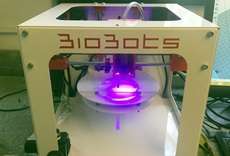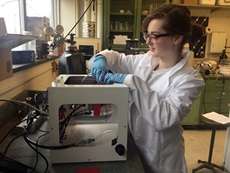3-D bioprinter allows students to create building blocks for new tissue

Advances in technology have made it possible to produce bone, muscle and even organs using a 3D bioprinter, which allows scientists to generate tissue in a laboratory environment.
But before that can be done, cellular building blocks have to be created to lay the foundation for the new tissue, and students at Rutgers University-Camden are playing the role of architect.
"We're interested in using carbohydrate and protein materials such as cellulose and silk to create scaffolding on which organs can grow," says Ashley Lewis, a junior majoring in both biology and philosophy. "You can't just randomly take cells and make an organ. You have to have some sort of infrastructure so that they will grow, and it's a nuanced process."
Lewis, a Gibbsboro resident, is one of several students working with the new technology under the tutelage of David Salas-de la Cruz, an assistant professor of chemistry at Rutgers-Camden. The 3D bioprinter – the first at Rutgers-Camden – was installed during 2015.
"By using this technology, our students are being exposed to the fundamentals of biomedical research," Salas-de la Cruz says. "How do the basic building blocks – the chemical structures – interact with each other to tune the material properties? It's giving Rutgers-Camden students insight into the fundamentals of science."

The students are characterizing the materials they'll be using as scaffolding to determine how applicable or functional they'll be with the cells used to create tissues.
"We're taking cellulose, for example, and using it with a solvent like ionic liquid, which can dissolve the cellulose," Lewis says. "We want to know what new form it takes, or what new properties it has."
Salas-de la Cruz says 3D printing has become a game changer in various industries, and engineers and business owners are using the technology to come up with innovative solutions to manufacturing their own tools, parts and products.
Students at Rutgers-Camden have been using 3D printers to build devices required for research projects, but this is the first time they are getting to work with biomaterials for 3D bioprinting. The possibilities are endless, and Salas-de la Cruz says 3D printing is now revolutionizing healthcare.
"As research continues, the creation of these renewable biomaterials is becoming more common and the technology can be used to create nerve connections and heart valves," he says. "It's amazing."
Salas-de la Cruz is particularly interested in designing polysaccharide or protein-based biomaterials that are biodegradable so that, after the scaffolding material is implanted in the body and the cells and tissues grow around it, the scaffolding will degrade on its own.
"You wouldn't have to wait until an organ is fully formed until it is implanted," Lewis says. "As it grows, the scaffolding degrades."
Students working in Salas-de la Cruz's lab say the 3D bioprinting project has given them significant research experience and has allowed them to work with an emerging technology that will have an impact on science for years to come.
"This creates a new boundary for students by which to set goals they want to achieve by the end of their college careers," says Chris Cherfane, a senior biology major from Cherry Hill. "Getting exposed to this technology now and being able to use it now gives us access to something that can really stretch us beyond what we were capable of before in terms of the research we do."
Salas-de la Cruz adds, "I want this to allow the students to explore on their own. That's all part of research and discovery and carving out a path through experimentation. It fosters new ideas and innovation. I want to see where it goes. I want to open their minds to possibilities."
Provided by Rutgers University





















